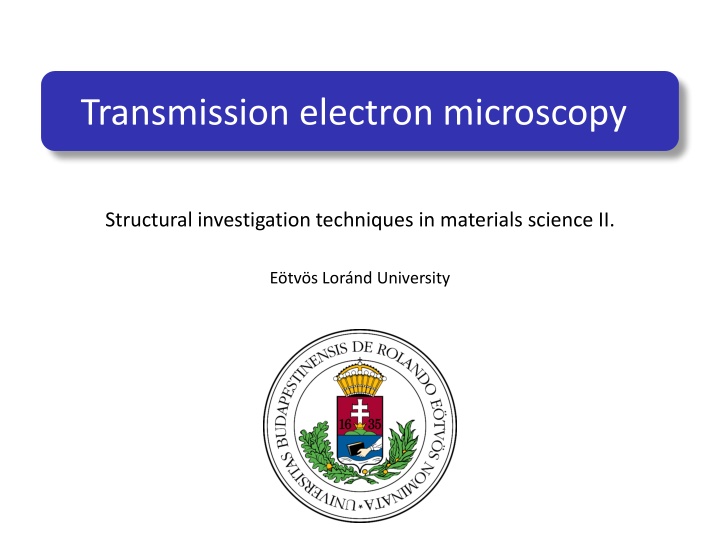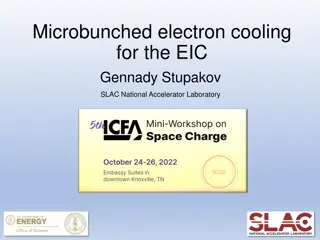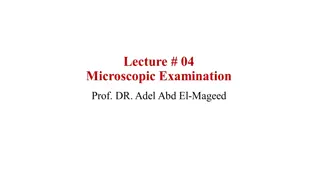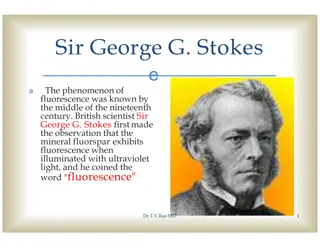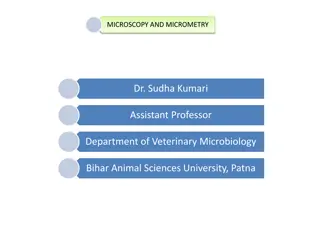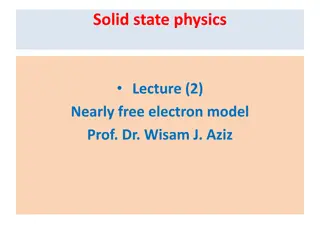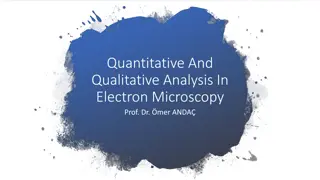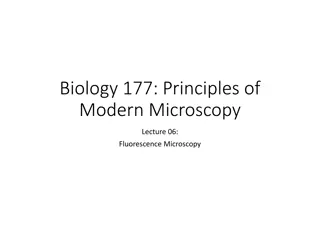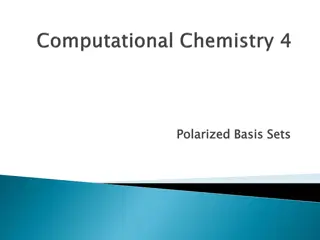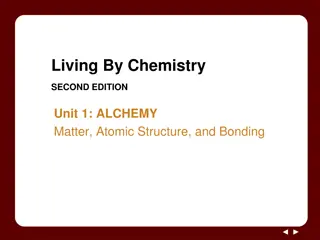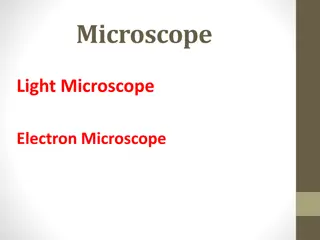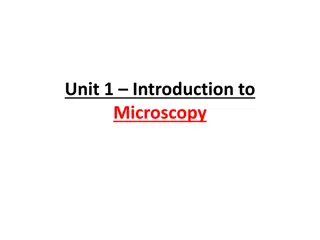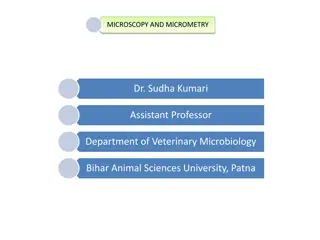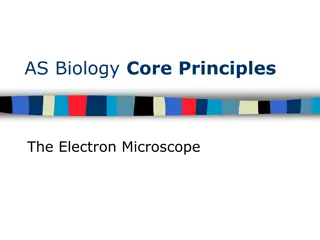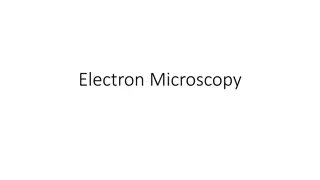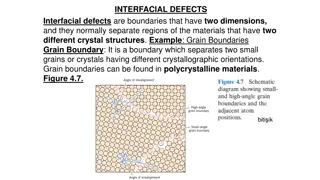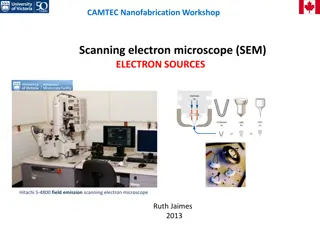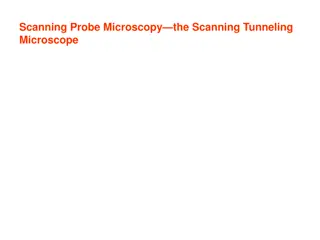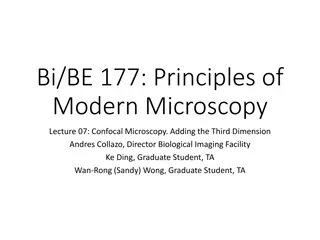Advanced Techniques in Materials Science: Transmission Electron Microscopy
Explore the advanced techniques used in materials science, focusing on Transmission Electron Microscopy (TEM). Learn about the challenges with optical microscopes, the principles of TEM imaging, and the application of scattering theory in electron microscopy. Discover how TEM offers higher resolution imaging by using electrons and the theoretical framework behind electron scattering and interference.
Download Presentation

Please find below an Image/Link to download the presentation.
The content on the website is provided AS IS for your information and personal use only. It may not be sold, licensed, or shared on other websites without obtaining consent from the author.If you encounter any issues during the download, it is possible that the publisher has removed the file from their server.
You are allowed to download the files provided on this website for personal or commercial use, subject to the condition that they are used lawfully. All files are the property of their respective owners.
The content on the website is provided AS IS for your information and personal use only. It may not be sold, licensed, or shared on other websites without obtaining consent from the author.
E N D
Presentation Transcript
Transmission electron microscopy Structural investigation techniques in materials science II. E tv s Lor nd University
Problems with optical microscopes We often find that microscopes are characterized by their magnification, but this is not the best way to describe the capabilities of the instrument resolution When passing through the instrument, light gets scattered on the different components of the microscope and this leads to the appearance of Airy-disks Two objects are distinguishable if their respective images don t overlap Kirchhoff s theory gives us the size of these disks The first minimum: For small angles: Structural investigationtechniques in materials science II. 2
Problems with optical microscopes To distinguish the two objects their angle (as seen from the lens) must be greater than To increase the resolution we can either increase the size of the lens, or decrease the wavelengthof the particle we re using. Light: = 200 nm (at most) e- (de Broglie: = h/p) we can reach = 0,14-0,4 nm atomic range 3 Structural investigationtechniques in materials science II.
TEM basic principles If we use electrons we can make a lot higher resolution images TEM Works basically like an optical microscope Incoming e--s The principles used in classical optics can be applied Object plane Instead of optical lenses magnets Lens Electrons pass through the object that we are trying to make an image of the object has to be thin < 200 nm; in high resolution imagery < 10 nm Focal plane Image plane Structural investigationtechniques in materials science II. 4
Scattering theory As the electrons hit the target similarly to light, they get scattered and interfere with each other. The theoretical framework: Kirchhoff s theory Solution of the Maxwell eq. in a special case: , Helmholtz eq.1 1Here is a function of the electrical potential and the vector potential. If at this point we introduce a source for the electromagnetic field inhomogeneous Helmholtz equation: The solution is given by the Fresnel integral Structural investigationtechniques in materials science II. 5
Fresnel-integral The Fresnel-integral is an approximate solution for the inhomogeneous Helmholtz equation: Charge density Spherical wave propagation Initial form of the wave In our case we are far away from the source of the wave (it can be shown that) the spherical wave part can be ignored The only important part of the integral is the scattering amplitude: where . Structural investigationtechniques in materials science II. 6
Scattering amplitude If we assume that the charge density is periodic: where with n we index the lattice points, and with j the atoms in a unit cell. Now, the amplitude factor can be broken down into three terms: Non-zero only if The calculations show us that the difference between the wave number of the incoming and outgoing wave can only differ by a reciprocal lattice vector Structural investigationtechniques in materials science II. 7
Braggs law We can represent our condition visually this is Bragg s law: The path difference of the waves is related to the distance between the crystal lattice planes if we can measure the angles, we know the dhkl distances all of this calculation will be valid for electrons too TEM Structural investigationtechniques in materials science II. 8
Another way to interpret Braggs law Ewald s sphere: reciprocal lattice draw k so that it points to a lattice point make a sphere around k's origin with radius k The points on the Ewald s sphere will be the ones that fulfill Bragg s law this is very hard to achieve, since we would need to fine-tune k so that it points exactly to a reciprocal lattice point we have to take into account the fact that the atoms are not point-like Structural investigationtechniques in materials science II. 9
Crystal diffraction What we can do is rotate the crystal so that the Ewald s sphere falls on a reciprocal lattice point even better if we use a powdered sample where we already have many crystals pointing in all directions the interference patter will be comprised of circles TEM image of a Si crystal TEM image of Ni powder Structural investigationtechniques in materials science II. 10
Crystal diffraction Why do we see many points and not just the points that fulfill Bragg s law? sample is finite and therefore the reciprocal lattice points become sticks Ewald s sphere is large compared to the reciprocal lattice basis therefore it intersects many sticks Structural investigationtechniques in materials science II. 11
What can we detect? In TEM accelerated electrons move through the specimen. Electron types after interaction with matter: unscattered (forward scattered) electrons elastically scattered electrons (diffraction) inelastically scattered electrons other types: secondary, backscattered, X-ray, Auger electrons Structural investigationtechniques in materials science II. 12
TEM structure Ernest Ruska (1933), Nobel Price in 1986 Average energy of electrons: 100 400 keV Wavelength of electrons from the dispersion relation of the free electrons: Even smaller than the size of an average atom. Errors: spherical aberration chromatic aberration astigmatism thick specimen (more diffraction, kinetic theory cannot be applied) t < 10 nm Structural investigationtechniques in materials science II. 13
TEM structure Main parts of TEM: electron gun condenser lenses specimen objective lenses intermediate lens projector lens image recording screen (image plate, CCD, etc.) Structural investigationtechniques in materials science II. 14
Operating modes Imaging and diffraction mode. Focal length depends on the current in the electromagnet. Switch between the two modes: change the focal length of the intermediate lens. Imaging mode: focal length of the intermediate lens equals the object distance Diffraction mode: focal length of the intermediate lens equals the rear focal plane distance Structural investigationtechniques in materials science II. 15
Imaging mode Magnified image of the specimen. Focal length of the intermediate lens equals the object distance. Brighter: more detected electrons Aperture: electrons can go only through this hole. If unscattered electrons: more electrons are detected brighter image bright field mode If one diffracted beam: less electrons are detected darker image dark field mode Only one diffracted beam, information loss, but difference in contrast. More detailed image (HRTEM): more diffracted beams larger aperture spherical aberration Structural investigationtechniques in materials science II. 16
Diffraction mode Magnified diffraction pattern of the crystal lattice appears. Focal length of the intermediate lens equals the rear focal plane. We detect the Fourier transform of the specimen in the focal plane reciprocal lattice can be seen All dots corresponds to lattice planes with different Miller indices. Bright dots: elastically scattered electrons Grey background: inelastically scattered electrons Diffraction aperture: information of a small area of the crystal Selected area diffraction (SAD) Structural investigationtechniques in materials science II. 17
Diffraction mode - examples Powder diffraction (Ni) Debye-Scherrer rings Structural investigationtechniques in materials science II. 18
Diffraction mode - examples Diffraction image of Si single-crystal (fcc) Diffraction of a GaN layer (hexagonal) Structural investigationtechniques in materials science II. 19
